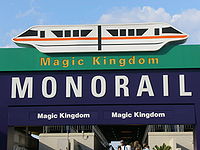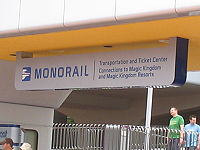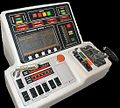- Walt Disney World Monorail System
-
Walt Disney World Monorail System 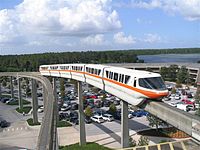
Info Locale Walt Disney World Resort Transit type Monorail Number of lines 3 Number of stations 6 Daily ridership 250,000 Website Walt Disney World Monorail System Operation Began operation October 1, 1971 Operator(s) Walt Disney World Resort Train length 203'6" long (62m) Technical Track gauge Single straddle-beam Average speed 40 mph (64 km/h) Top speed 55 mph (89 km/h) The Walt Disney World Monorail System is a public transit system in operation at the Walt Disney World Resort.
The Walt Disney World Resort currently operates twelve Mark VI monorail trains on three lines of service.[2][3] The monorail system opened in 1971 with two routes and with Mark IV monorail trains. It was expanded to three lines in 1982, and switched to Mark VI trains in 1989.[2]
Contents
Lines and stations
Walt Disney World Monorail System Legend





Shops Spur Magic Kingdom 




Contemporary 




Grand Floridan 



Epcot Spur Transportation Center 

Polynesian 




Epcot 











Express Service 
Resort Service 
No passengers 
Ferry Service The Walt Disney World Monorail operates over a span of 14.7 miles (23.7 km), with around 50 million Disney guests traveling on the monorail each year.[4]
The three services on two distinct routes on the Walt Disney World Monorail are: [5]
- The Express and Resort services on the dual-beam Magic Kingdom route:
- Express: Express service between the Magic Kingdom and the Transportation and Ticket Center (TTC). Express service runs on the outer loop of this route and travels counter-clockwise.
- Resort: Round-trip local service on the inner loop, running clockwise, making stops in order at the Magic Kingdom, Disney's Contemporary Resort, the Transportation and Ticket Center, Disney's Polynesian Resort, and Disney's Grand Floridian Resort and Spa.
- The single beam Epcot route:
- Epcot: Service between the Transportation and Ticket Center and Epcot. Service on this route is a single beam running clockwise on the loop.
A spur track connects the Express and Resort lines to the maintenance shop. Another spur connects the Epcot and Express lines and is located northeast of the Transportation and Ticket Center.
Infrastructure
The monorail beams, which are made of concrete with a special polystyrene core to lighten their weight, came by train from Washington.[5]
The system opened with the rest of the Walt Disney World Resort on October 1, 1971. It initially featured four stations: the Transportation and Ticket Center, Disney's Polynesian Resort, the Magic Kingdom and Disney's Contemporary Resort. The Epcot line and station were added during that park's construction, opening officially on October 1, 1982. The most recent addition was the Grand Floridian station, which was opened in 1988 along with the resort hotel.
During the construction of Epcot, Florida residents could request a complimentary ticket for a round-trip on the Epcot line to get a sneak preview of the park.[citation needed]
Trains
Specifications
The modern trains that have been in use since 1989 are each 203' 6" long (consisting of six cars) and can carry 364 passengers. The trains are driven by eight 113 HP motors which are powered by a 600-volt electrical system running through a busbar mounted on each side of the concrete beam.[6] Each train also has seven inverters on board that convert the 600 VDC to 230 VAC for use by the air conditioners and air compressor, and additionally has a battery-backed 37 VDC low-voltage supply that provides power for the train's electronics. The trains are also equipped with a towing knuckle at each end to allow it to be pushed or pulled by a special diesel-powered tractor if need be. Maximum speed during normal operations is 40 mph, with several speed zones throughout the system with limits ranging from 15 to 40 mph. These speed limits are strictly enforced by the train's computer and cannot be overridden without the operator engaging a special lockout. Attempting to drive the train too quickly in a given speed zone will result in an "overspeed stop", often subjecting the driver to good-natured ridicule by his co-workers.[citation needed] Train spacing is maintained by the Moving Blocklight System (MBS), also known as the MAPO system (for "Mary Poppins", U.S. Pat. 3,973,746), which establishes a number of "holdpoints" throughout the system. At any given time, there must be at least two holdpoints between a given train and the train ahead of it. When the train detects that there are fewer than two holdpoints between itself and the preceding train, the emergency brakes are immediately applied and cannot be released until sufficient spacing becomes available or the operator explicitly overrides the system. Failure to maintain adequate spacing is known as an "overrun", and is treated as an extremely serious offense.[citation needed]
Operations
The Disney employees that operate monorail trains are called pilots, comprising a distinct and separate department within Disney Transportation. Buses and Watercraft (ferryboats, launches, and cruisers) are the other two departments, and each department is trained and scheduled separately from the others.[citation needed] One employee is scheduled as the central coordinator ("Monorail Central") during each shift. "Central" controls the operation of the entire monorail system, usually by issuing instructions to pilots via radio. Central is responsible for setting up each day's operation in the morning, for handling contingencies and emergencies that occur during the day, and for moving trains off the system after all parks have closed. An employee can act as Central only with a history of safe train operation, the ability to train other monorail pilots, and a rigorous training period during which they must successfully triage and handle simultaneous simulated emergencies. Monorail Central operates out of the glass booth on the Epcot Load platform at the Transportation and Ticket Center. Several qualified coordinators are usually available during each shift that can take over Central's duties if needed.
The manager who oversees all monorail operations during a given shift at Walt Disney World is called "Monorail One". This Guest Service Manager (GSM) handles guest matters, including complaints and arrangements for alternative transportation, such as ferry boats or buses, in the event of monorail downtime.
Monorail workers refer to the system's stations as follows: "Concourse" includes the load and unload platforms for the Epcot beam at the Transportation and Ticket Center.[citation needed] "Base" includes the platforms for both the Express (the exterior beam) and Resort (the interior beam) beam at the Transportation and Ticket Center; however, the monorail workers refer the Resort side of base as "Base Resort". (See map in this article) The stations at the Polynesian, Grand Floridian, Contemporary, at the Magic Kingdom, and at Epcot are named after each location.[citation needed]
Identification
Each train is identified by a colored stripe, and given a name according to that color.[5] The complete list of colors used is below. To help visually identify Green from Lime and Pink from Coral, the Lime and Coral stripes have a white delta painted on each car.[7] Originally, Monorail Lime's deltas (and those of the older Mark IV Lime) were painted a dark blue in homage to the original Walt Disney World monorail cast's costume colors (lime and blue), but the colors were changed when the entire monorail fleet was repainted in the early 2000s.
In November 2009, Disney put Monorail Teal into service. Monorail Teal was built using the undamaged portions of the two trains involved in a fatal accident in July 2009.[3] [8] The colors of the two trains involved, Pink and Purple, will be retired from service.[3] The twelfth train (Peach) will be placed into service in Fall 2011 to restore the resort's fleet back to 12 trains.[9]
On March 19, 2010, Disney debuted Monorail TRON, which ran on the Epcot line. As marketing for the 2010 film Tron: Legacy, Monorail Coral was covered in a full piece of TRON artwork. The nose cones of the monorail were painted blue, while the rest of the artwork was a wrap. "Monorail TRON" was removed from rotation in July 2011 and has returned to its normal route as Monoral Coral.
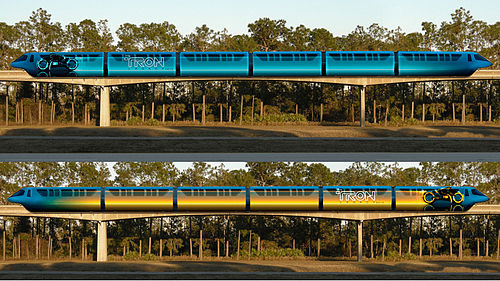 For a while, Monorail Coral featured TRON artwork from Disney's Tron: Legacy. It ran on the Epcot line.
For a while, Monorail Coral featured TRON artwork from Disney's Tron: Legacy. It ran on the Epcot line.
The newest monorail, Peach, debuted on or before Oct 16, 2011.
 Oct 22, 2011 outside Disney's Polynesian Resort.
Oct 22, 2011 outside Disney's Polynesian Resort.
The current train identification colors include:
- Red
- Coral (white deltas)
- Orange
- Gold
- Yellow
- Teal (white deltas)[8]
- Lime (white deltas)
- Green
- Blue
- Silver
- Black
- Peach
Retired colors:
- Purple
- Pink
Front-cab riding
There is seating for up to four guests in the front cab of the train with the pilot who manually drives each train. These were offered on a first-come/first-serve basis, and a pilot gave out "co-pilot licenses" at the end of the journey. Front cab riding was suspended after the July 5, 2009, incident.
Pre-recorded Spiels
The monorail system uses a set of pre-recorded announcements to instruct and entertain passengers. Prior to departure when the pilot closes the doors, an announcement asks guests to "Please stand clear of the doors. Por favor manténganse alejado de las puertas." One of the most known phrases within the resort, it was recorded by Jack Wagner, who was known as "the Voice of Disneyland." In 1988 following the construction of the Grand Floridian Resort stop, Kevin Miles replaced Jack Wagner as the voiceover. Wagner can still be heard today as the "Please stand clear of the doors ..." phrase remains with his voice, partly as it is installed on a separate system. Miles worked in Epcot as part of the 'Voices of Liberty' in the American Adventure pavilion at World Showcase. In 1998, Disney employee Matt Hanson replaced Kevin Miles, and in 2004 Hanson was replaced by Joe Hursh. Hanson is still with the Walt Disney Company.[10] During the system's early years, the trains featured Wagner's narration of the sights and scenery along the way, as well as information on special events, the resort, and the monorail system itself.[10] Today the "stand clear" instruction remains in Wagner's voice. This is at least partially due to the fact that the audio for the doors is generated via a separate system than that for the rest of the narrations.[citation needed] Disney monorail workers refer to these narrations as "spiels." [11]
Maintenance
Monorail Shop ("Shop" for short) is Disney's monorail maintenance facility located a short distance northeast of the Magic Kingdom, and provides space for up to nine of the eleven Mark VI trains on its upper level (the bottom level houses the four steam locomotives that circle the Magic Kingdom on its west side, and a bus repair facility on the east side). On any given night, two monorail trains[7] (and often more) are parked at various stations on the system, depending on which beam Shop has determined they are to be run the next day. On nights where the temperature drops below freezing, the trains will be parked inside the Contemporary Resort; but in practice, trains can be left in any station (even on the express side of a resort station). No train will ever be left outside two nights in a row because routine maintenance is performed nightly.
The Monorail Shop also has a painting room located on Beam 10 that is elevated 25 feet (7.6 m) off the ground and has a lift mounted on the wall for the painters. It takes three weeks to paint a monorail train.[7] To access the wheels and underside of the monorail, a portion of Beam 1 inside Shop is removable, primarily used to change load tires.
Towing
The diesel-powered "work tractors" are the tow trucks of the system, and can tow a train to Monorail Shop, located around the bend from Space Mountain. Monorail Operations at the Walt Disney World resort has three separate tractors that allow for the simultaneous towing of three different monorails.[7] In the event of a power failure on one of the monorail lines, the tractors are still operational, as they are powered by on-board diesel engines.
Safety
Train safety
Safe train spacing is maintained via a moving blocklight system, referred to as MAPO, installed in the cab of each train.[5] MAPO appears in the top center of the pilot's console and looks similar to a horizontal stop light. There are three lights—green, amber, and red—and a push-button labeled "Override". The term "MAPO" itself comes directly from Walt Disney, who formed a new company to deal with Disneyland's transportation system directly from the profits made by Mary Poppins.[12]
Each monorail beam is divided into blocks based upon pylon numbering. The currently illuminated MAPO color indicates how far ahead the leading train is currently located. A green MAPO shows that the leading train is 3 or more blocks ahead, amber means 2 blocks ahead, and red indicates that the next train is in the very next block. A block is roughly between 500 and 1000 feet (about 150 and 300 m) long, although this varies. The start of each block is called a "hold point", as pilots may need to hold their trains at that location until the train ahead moves away. Guests riding in the front cab of a monorail can identify hold points by the yellow reflective tape around a pylon's number and by two yellow reflectors attached to the top outside edges of the monorail beam at that pylon.
For safety, trains must be kept at least two blocks apart during normal operation. A red MAPO indicates that train spacing has become unsafe. When a red MAPO occurs, the train's on-board computer locks out the pilot's propulsion control and applies emergency brakes. The pilot cannot resume control of the train until either the MAPO clears or the pilot presses and holds the MAPO override button.[5]
It is the pilot's responsibility to avoid a red MAPO during normal operation. When the MAPO switches from green to amber, this indicates that the monorail is approaching the train ahead. The pilot must stop the train before crossing into the next block of beam way and hence before the MAPO switches to red. Should a pilot cross the hold point and receive a red MAPO, this counts as a safety demerit against the pilot. If a pilot accumulates three demerits on his/her record within a two-year period, then he/she will be transferred out of the monorails department and into a different role at Walt Disney World.[13]
Safety tests are performed daily to ensure that the MAPO system is working properly on each train. At the direction of the monorail station conducting the test, each train will intentionally overrun a hold point to verify that a red MAPO occurs and that the emergency brakes activate. Pilots perform tests in forward and reverse when bringing a train onto the system for the first time that day. The indications are called into Monorail Central with the emergency brake pressures.
A red MAPO will also occur when the pilot approaches a section of un-powered beam, a spur line, or a switch beam thrown in the direction of a spur line. Pilots must engage the MAPO override when moving trains through a switch to the spur line. Red MAPOs occurring due to safety tests, switching, or beam power loss do not count as demerits against the pilot.
Emergency evacuation
Emergencies requiring train evacuation will be handled differently depending upon the location of the train and the nature of the emergency.
If a train is stopped at a station platform or at the work platform along the Epcot beam, guests can exit the train onto the platform. Exiting a train is possible even when the doors of the train cars are closed. The large rectangular window in the middle of each car is an emergency exit and can be removed from the interior of the car. A cast member outside the car can also forcibly open the rightmost door panel of the car by releasing the air pressure holding that panel closed. The air pressure release is a handle beneath the rectangular center window that is similar in appearance to a car door handle.
If a train is stopped on open beam, then guests evacuate through emergency exits located in the roof of the train. Guests open roof hatches by first removing decorative plastic from the ceiling above a bulkhead footstool and then by lifting open a hinged hatch that will flip across the bulkhead dividing two train cars. Guests evacuate to the roof by climbing through the open hatch onto the top of the train. The bulkheads separating cars are designed as firewalls that will contain a fire within a car to just that car. The open hatch allows guests in the affected car to transfer to an adjacent car where they can safely wait for evacuation by fire response crews.
If the emergency affects the entire train, then guests are evacuated to the surface of the beam. Guests again open the emergency roof hatches, but do not simply move to the adjacent car. Instead, they use a small handrail present along the top of each train car to move all the way to the front of the train. The train's pilot can attach a knotted rope to both the top and the base of the windscreen, and guests use the rope to shimmy down the windscreen to the surface of the beam. They finally start walking along the beam away from the train.
Reedy Creek Emergency Services provides fire response and rescue for the Walt Disney World Monorail System and maintains an all-wheel-drive fire truck specially designed for monorail rescue.[14]
Platform safety
Some stations have remotely-opened or even automated gates that bar riders from approaching the monorail beamway (and, thus, any approaching or departing train) until the operators have determined that it is safe to allow people to board the train.[15] The cast member at the station gives the riders instructions on how to board. Other stations have manually operated gates to serve this function.
As the train floor is slightly raised above the platform, a portable ramp must be used to load guests in wheelchairs. For many years, the Contemporary Resort station did not have disabled access. An elevator has since been added to the platform.
Incidents
Main article: Incidents at Walt Disney World ResortWhile a number of accidents and injuries have occurred on the monorails since Walt Disney World opened, there has been only one death. On July 5, 2009, a driver was killed when two monorails collided (Pink and Purple). It was the first fatal accident in the monorail's history.[16]
Walt Disney World monorail trains
Built by Martin Marietta
Mark IV Monorail Period of Service 1971 to 1991 Length: 5 cars: 171' 6 cars: 201' Width: 8' 10” Height: 11' 7” (7' above top of beam) Weight (lbs): 5 cars empty: 92,000 5 cars gross: 122,600 6 cars empty: 108,500 6 cars gross: 145,100 Built by Bombardier Transportation
Mark VI Monorail Period of Service 1989 to Present Length: 203' 6" long (62m) Width:(from outside) 8' 4.5" (2.55m) Height:(Head Room: From Top of Floor to Bottom of Headliner) 6' 10.75" (2.1m) Tall:(From Bottom of Skirt to Top of Shell) 10' 5.5" Weight (lbs): 5 cars empty: 92,000 Passenger capacity: 20 seated passengers - per car 40 standing passengers - per car 360 people - total train See also
- Disney Transport
- Disneyland Monorail System
- Incidents at Walt Disney World
- List of rapid transit systems
- List of monorail systems
References
- ^ The Monorail Society. "Walt Disney World". http://www.monorails.org/tMspages/WDW.html. Retrieved 2007-06-23.
- ^ a b Monorail Express. "Facts". http://www.monorailexpress.com/page2.html. Retrieved 2007-06-13.
- ^ a b c Jason Garcia (2009-10-15). "Walt Disney World to bring new monorail train into service". Orlando Sentinel. http://www.orlandosentinel.com/business/orl-bk-disney-world-monorail-101609,0,3042435.story. Retrieved 2009-10-15.
- ^ Modern Marvels: Walt Disney World.
- ^ a b c d e NYCSubway.org. "Walt Disney World Monorail". http://world.nycsubway.org/us/disney/. Retrieved 2007-06-13.
- ^ Neal, Julie; Mike Neal. The Complete Guide to Walt Disney World (1st Edition ed.). Coconut Press. ISBN 978-0970959645.
- ^ a b c d WDW History. "Disney Monorail". http://wdwhistory.com/wiki/Monorail/. Retrieved 2007-06-13.[dead link]
- ^ a b Garcia, Jason (November 5, 2009). "‘New’ monorail train goes into service at Disney World". Sentinel Teal Service. http://thedailydisney.com/blog/2009/11/new-monorail-train-goes-into-service-at-disney-world/. Retrieved 2009-11-05.
- ^ Jason Garcia (August 12, 2011). "Disney new monorail: Disney World to add new monorail train". Orlando Sentinel (Orlando, Fla.: Tribune Company). ISSN 0744-6055. http://articles.orlandosentinel.com/2011-08-12/travel/os-disney-new-monorail-20110812_1_monorail-driver-austin-wuennenberg-new-monorail-train. Retrieved September 15, 2011.
- ^ a b Mongello, Lou (2004-04-21). "Please stand clear of the doors... Por favor mantenganse alejado de las puertas...". Ask Lou. Disney World Trivia.com. http://www.disneyworldtrivia.com/article/ask_lou/66/please_stand_clear_of_the_doors_por_favor_mantenganse_alejado_de_las_puertas/. Retrieved 2007-10-05.
- ^ "Mark VI LMCU 1 Console". http://www.tiggerfan.net:81/wws/spiel.jpg. Retrieved 2008-12-29.
- ^ "Hidden Mickeys". Hidden Mickeys.org. http://www.hiddenmickeys.org/Secrets/Imagineering.html. Retrieved 2007-06-21.
- ^ "Disney World Monorail". http://www.orenstransitpage.com/otpdisneypics/monorail.htm. Retrieved 2007-09-20.
- ^ The Reedy Creek Fire Fighters Association Local 2117. "Our Apparatus". http://www.reedycreek.org/apparatus.html. Retrieved 2007-06-23.[dead link]
- ^ "Transportation News & Information". WDWMagic. http://www.wdwmagic.com/transportation.htm. Retrieved 2007-06-21.
- ^ Monorail Crash. "Crash". http://www.news-press.com/article/20090706/NEWS01/907060355/1075. Retrieved 2009-07-06.[dead link]
External links
- "Monorail Express". monorailexpress.com. http://www.monorailexpress.com. Retrieved August 2, 2006.
- "Disney World Monorail". NYCSubway.org. http://world.nycsubway.org/us/disney/. Retrieved August 2, 2006.
- "Disney's Monorail". WDWHistory.com. http://wdwhistory.com/wiki/Monorail. Retrieved August 2, 2006.
- "WDW Monorail via BFC". bigfloridacountry.com. http://www.bigfloridacountry.com/monorail.htm. Retrieved August 2, 2006.
- Walt Disney World Monorail System - WDWMagic.com (Unofficial WDW Site)
People mover and monorail systems in the United States AirTrain JFK • AirTrain Newark • Detroit People Mover • Disneyland Monorail • Huntsville Hospital Tram System • Indiana University Health People Mover • JTA Skyway • Las Colinas APT System • Las Vegas Monorail • Mandalay Bay Tram • Memphis Suspension Railway • Metromover • Morgantown PRT • Seattle Center Monorail • Walt Disney World MonorailCategories:- Monorails
- Railways of amusement parks
- Walt Disney World transit
- Walt Disney World Resort
- Rapid transit in Florida
- ALWEG people movers
Wikimedia Foundation. 2010.


